
This is one of our top picks in the category so we recommend it over others (you're on the right page), read below to learn why we love and recommend it! ⤵
This is one of the better tools in its category, see below if this tool is right for you! ⤵
Motion is the most innovative AI-powered project management tool for individuals and teams who want to fully embrace AI to get work done.
It uses AI to take all of your team's projects, tasks, priorities, deadlines, and dependencies to build the perfect day for you and your team, time blocking tasks right on your calendar. They also have AI Employees (AI workflows), AI Docs, & an AI Note Taker, helping you get work done faster 🚀
It's the closest "AI agent" tool that we've experienced that actually gives the feeling of having a true personal assistant with full context of the business. Try a free 7-day trial.
We believe there are better options available in this category, read below to learn what they do well, and what they could do better. ⤵
.svg)
-v2.webp)
Use AI to plan your work, automatically. Be 137% more productive. Use the AI assistant for busy people and work teams.
-v2.webp)
Let me guess: you and your team have hundreds of tasks to get done across dozens of projects, all with varying upcoming deadlines. And then when you have some time to figure out what you should do next, you have an unexpected meeting that pops up and totally breaks your focus.
Whether you're trying to figure out what would be the most impactful to move projects forward, or just updating your team on the work that everyone is completing, the reality is, you're spending more time managing the work that needs to be done than actually doing it.
Motion aims to solve this problem. It's a calendar, task manager, project management software, and meeting scheduler, all in one tool, with AI roping everything together. And they recently added AI Employees as well (but more on that later) 👀
Using AI, Motion analyzes your workload and automatically optimizes your daily schedule to help you/your team get more work done.
In this review, learn how Motion can boost productivity through:
Motion isn't just a calendar app, scheduler, task manager, project management app. It's really an AI Assistant at the core, that takes all of this unique information, and uses it to build your perfect day, making it one of the best productivity tools on the market.
But recently, Motion added AI Employees (requires upgrading to a higher tier). AI Employees pull context from your tasks, projects, AI notes, and meeting notes. With that, Motion isn't just a tool to help you manage work—it actually helps you get work done.
Compared to other top project management tools, Motion is far ahead when it comes to leveraging AI to help teams get ahead 🚀
Start a 7-day trial to follow along and let's dive in ⤵:
If you notice that you're spending more time managing your work than actually getting work done, Motion might be the solution you've been looking for.
After 7 years of using Asana, we actually switched entirely to Motion App because of the drastic time-saving component of helping us get our work done more efficiently. Motion is designed to help teams get more work done instead of just helping to manage work.
Motion is ideal for:
If you've tried Asana, Jira, ClickUp, or Monday and found that you were spending way more time managing your work than, well, working, then Motion might be a breath of fresh air.
Let's look closer at the features that make Motion stand out from other productivity tools.
Here are some of the key features that make Motion stand out:
Other project planning software requires you to spend chunks of your day re-evaluating deadlines and shifting back work. Not to mention, they have no actual reference of your calendar, so actual deep work and focus time available isn't even taken into account when you're in meetings... 😅
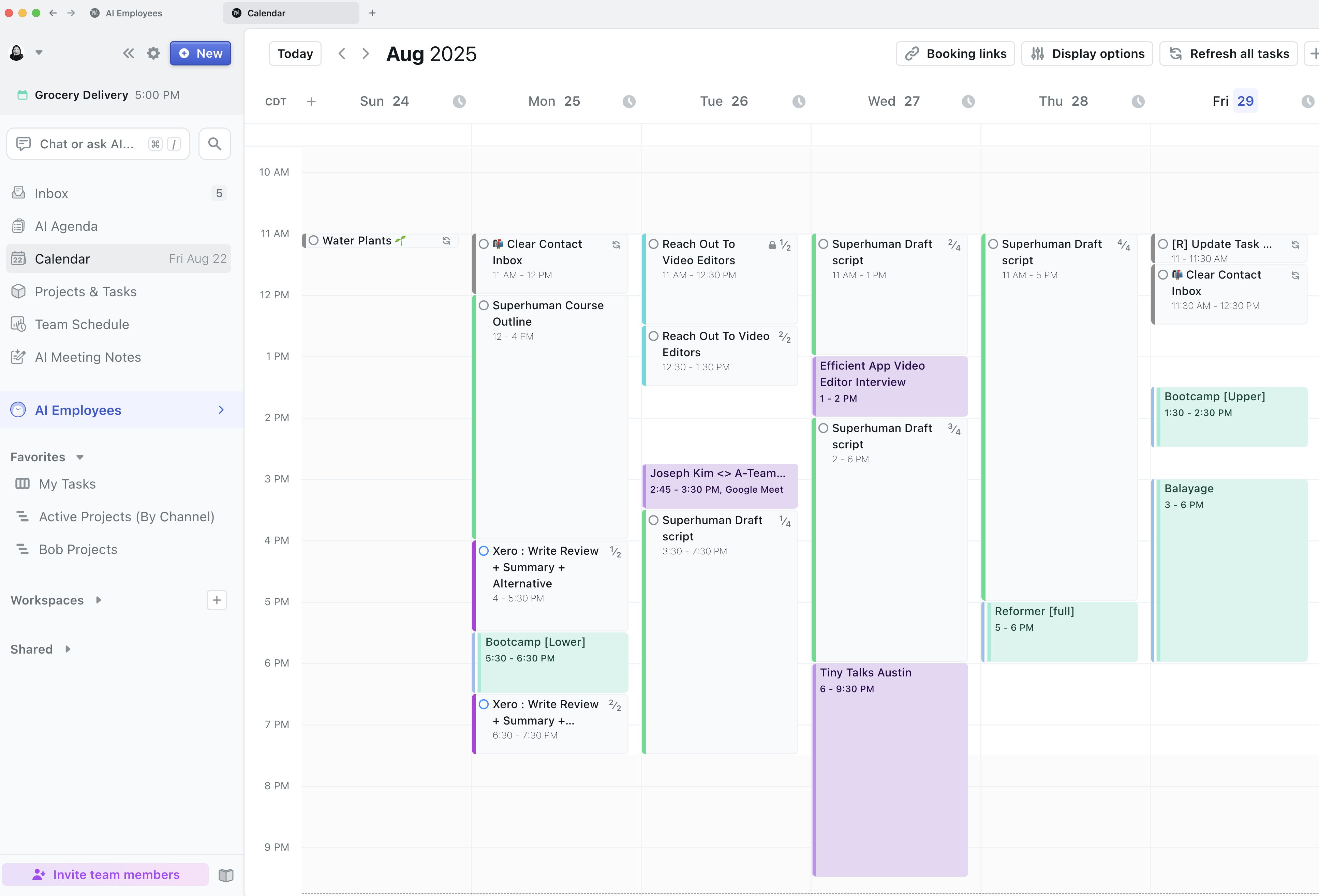
That's where Motion is different, and in some ways, in a category of its own. What they are doing is unmatched in the project management software space, and when you compare Motion alternatives like Motion vs Asana amongst others in the category, you see how outdated traditional task management tools and truly are.
They've leveled up your project management software with a baked in calendar scheduler that takes into account your task list and hard deadlines, along with time blocking to only recommend the best times for you to meet with others, ensuring that you can still get your work done on time. Something that no other project management software can do.
Oh, and whenever things don’t go according to plan (which they never do), Motion automatically re-prioritizes everyone’s tasks and calendar so that everything gets done, on time. Helping de-stress teammates by offloading all of the cognitive processing surrounding what should be done next.
Motion also lets you use AI to create projects. When you have a new project or workflow, instead of mapping out every single step, you can just write one prompt and Motion will generate a full project template for you. From there, you can edit and customize it to fit your needs.
We've found this is a great way to kick things off quickly. And once you're happy with the process, you can save it as a template to reuse again and again.
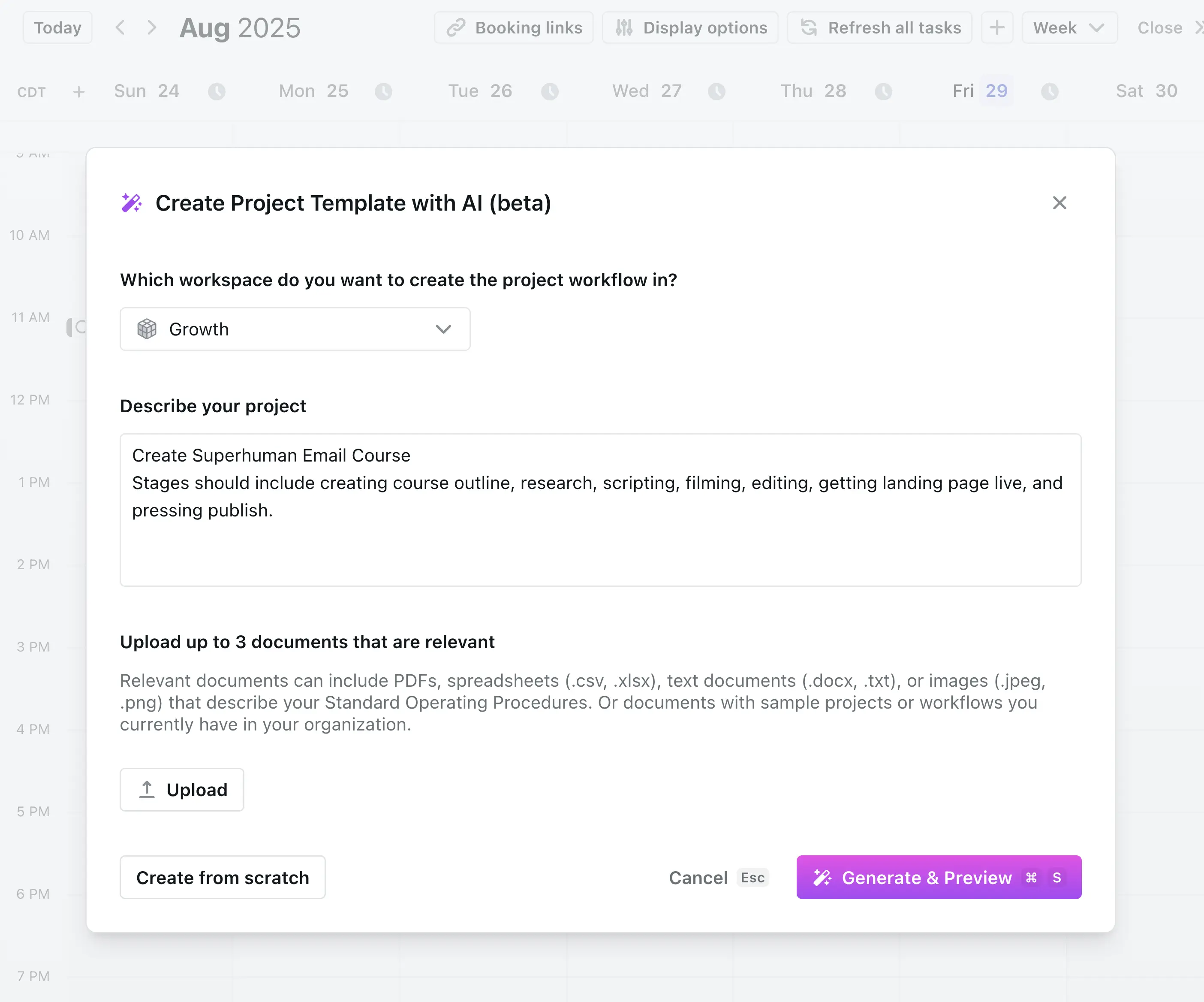
Motion also has project stages, which is unique compared to most project management tools. Stages act like milestones, each one has subtasks that need to be completed before you can move on to the next stage.
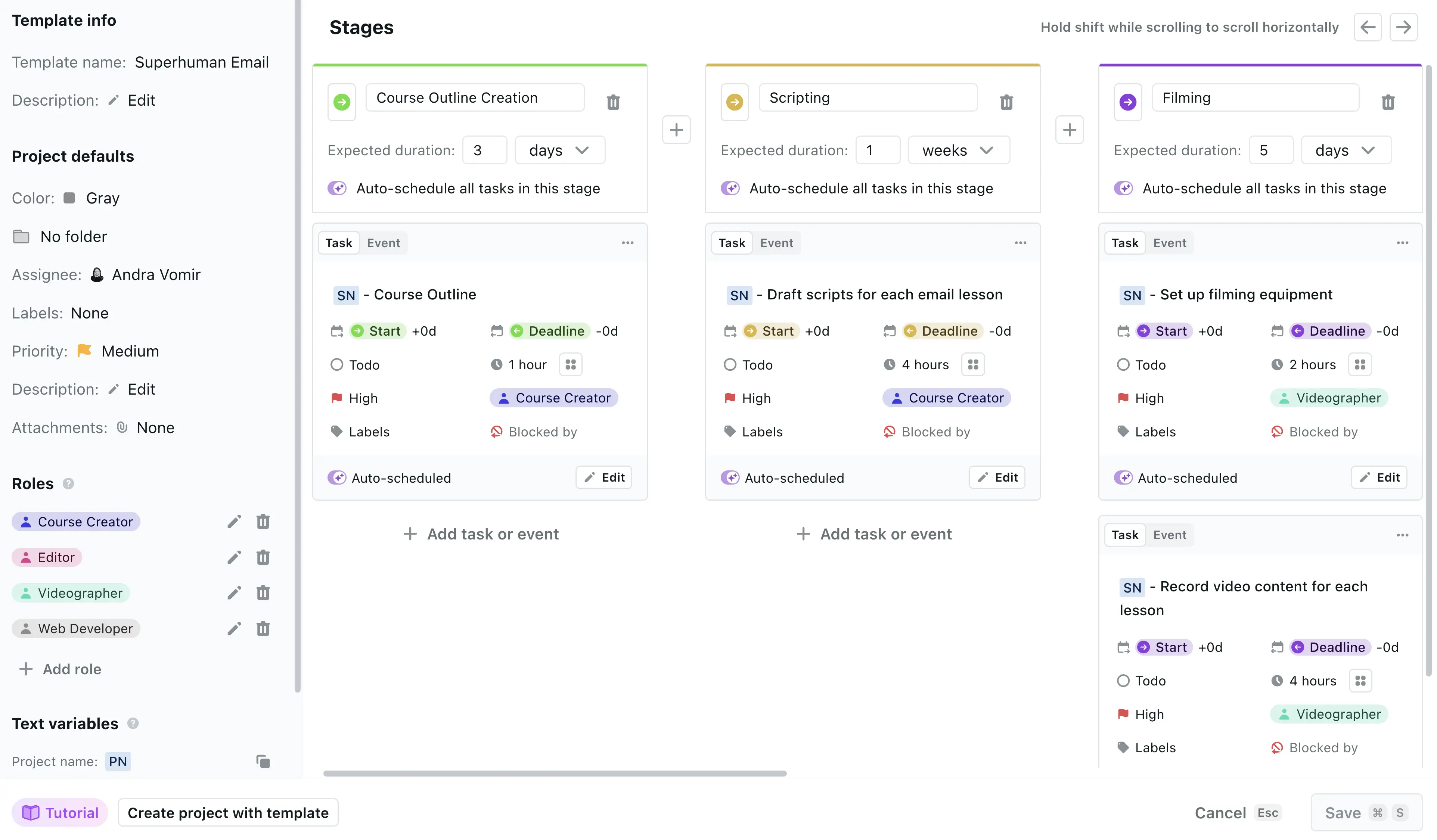
Because Motion is tied to your calendar, you can set deadlines for each stage, and Motion will instantly show you whether your team is on track to hit them or if you need to readjust.
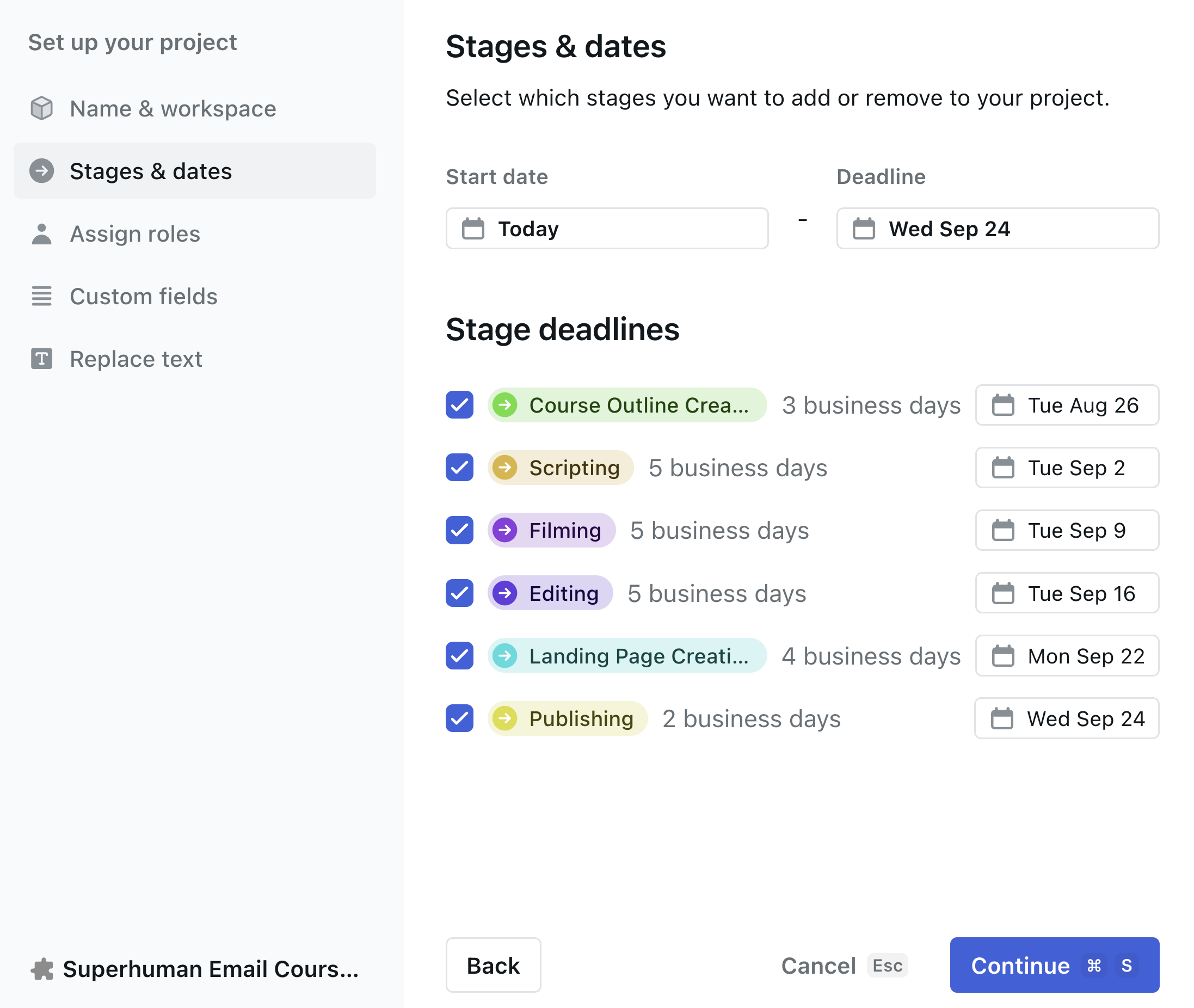
In terms of your project management features, you'll get unlimited projects, a fully featured task management tool, equipped with the main task views you need, including list views and kanban boards. There's highly customizable task priority, deadline, and task dependencies.
-v2.webp)
What makes it a fully featured project management tool is the ability to track tasks and assign them across team members, making for a powerful team management system along with team collaboration features. You can set custom personalized or team-wide filtered views so if you want a certain workspace to display tasks in a kanban board, while another showing it in list view, you can do both.
With other tools like Asana, you need to manually reschedule your tasks manually on a daily basis, wasting anywhere from 20–60 minutes per day—something you rarely need to think about with Motion. Team members that use Motion app report getting more done and worrying less about "figuring out what to do next".
Start your 7 day free trial of Motion here.
Motion just rolled out their new AI Employees feature. It's still early (more beta than finished product) but you can see the direction they're heading, and it's exciting.
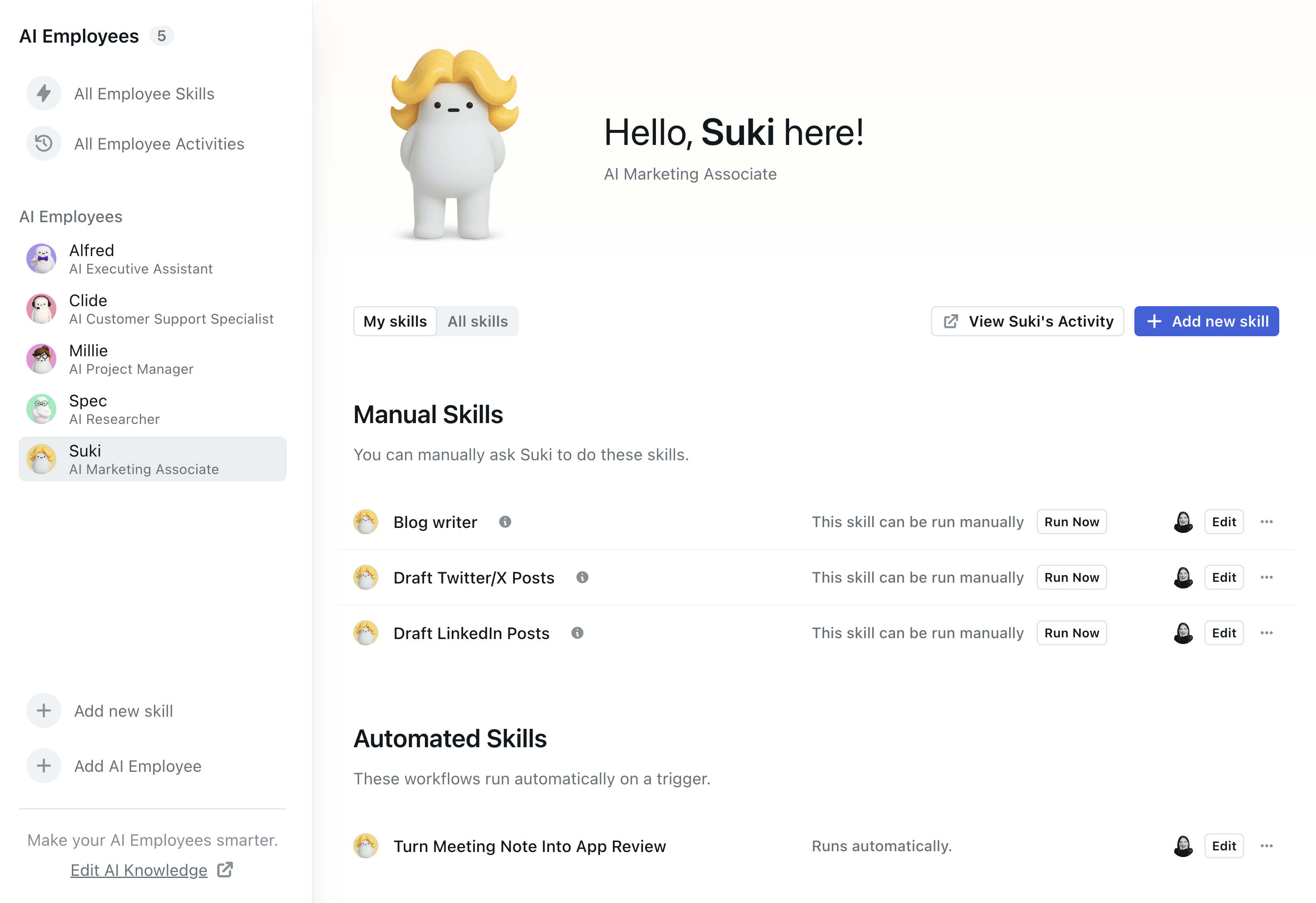
The idea behind Motion's AI Employees is simple: you give them work, and when it's ready, a task appears on your calendar for review, just like with an actual employee.
Right now, there are a few ready made AI Employees: a Marketing Associate (Suki) who can draft social posts or blog content, a Customer Support Specialist (Clide), and an Executive Assistant (Alfred) to help organize your inbox and draft replies. You can also build custom workflows, though they require you to know your process inside out to use successfully.
To get the most out of AI Employees, make sure to edit your AI Knowledge inside Motion. Add your website and anything that gives AI context. It makes a noticeable difference in the quality of work.
AI Employees are tightly integrated where you already manage your work (Motion). You can trigger them directly from a project or note, which means less tool switching and less copy-paste.
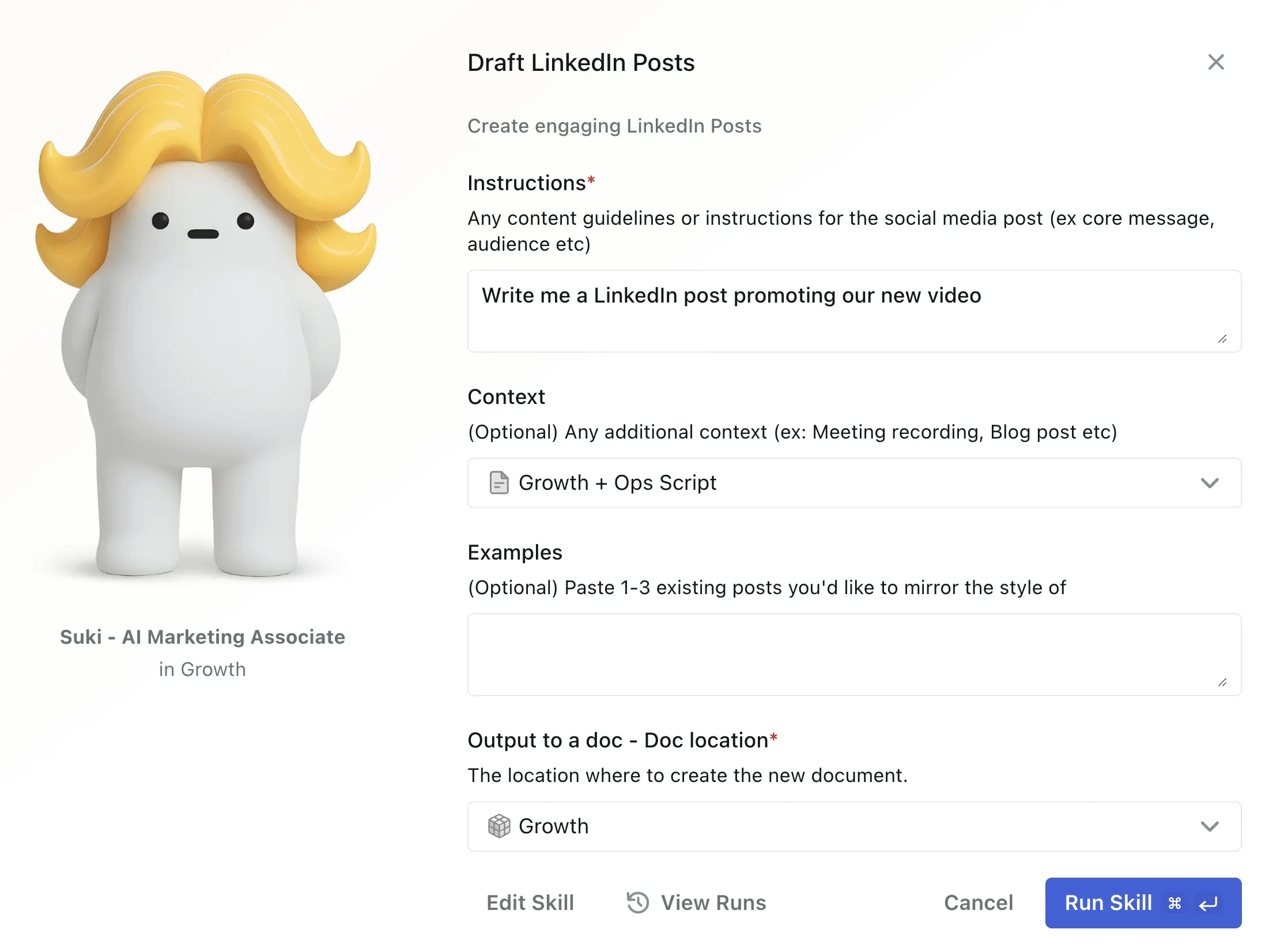
As users, we're still evaluating exactly how often we're leaning on them and testing out different custom AI employees based on our processes. ChatGPT has been our main go-to for most tasks over the past several years, but as Motion gains more context about our business, the goal is to gradually shift more routine tasks over.
Our favorite so far? Alfred, the Meeting Coach. After a call, Alfred gives feedback on how it went: likelihood of success, areas to improve, and even coaching like whether you interrupted too much or came across unprepared. It's been humbling at times (🙈), but also incredibly useful for self-reflection and improvement.
Bottom line: AI Employees are a glimpse into where Motion is going. They're not perfect yet, but if you're already using Motion for project management, they're worth exploring.
We LOVE Motion's Meeting Recorder, and if you're already using Motion for your projects, there's really no reason to use another one. It automatically joins your meetings (you just have to let it in), records video and text, and then uses AI to organize the notes for you.
The quality of the notes are fantastic. When Bob, a new team member, had his first call with another engineer, he tried Motion's AI meeting note taker for the first time and was blown away. He said they were better than anything he could have written himself! And we agree.
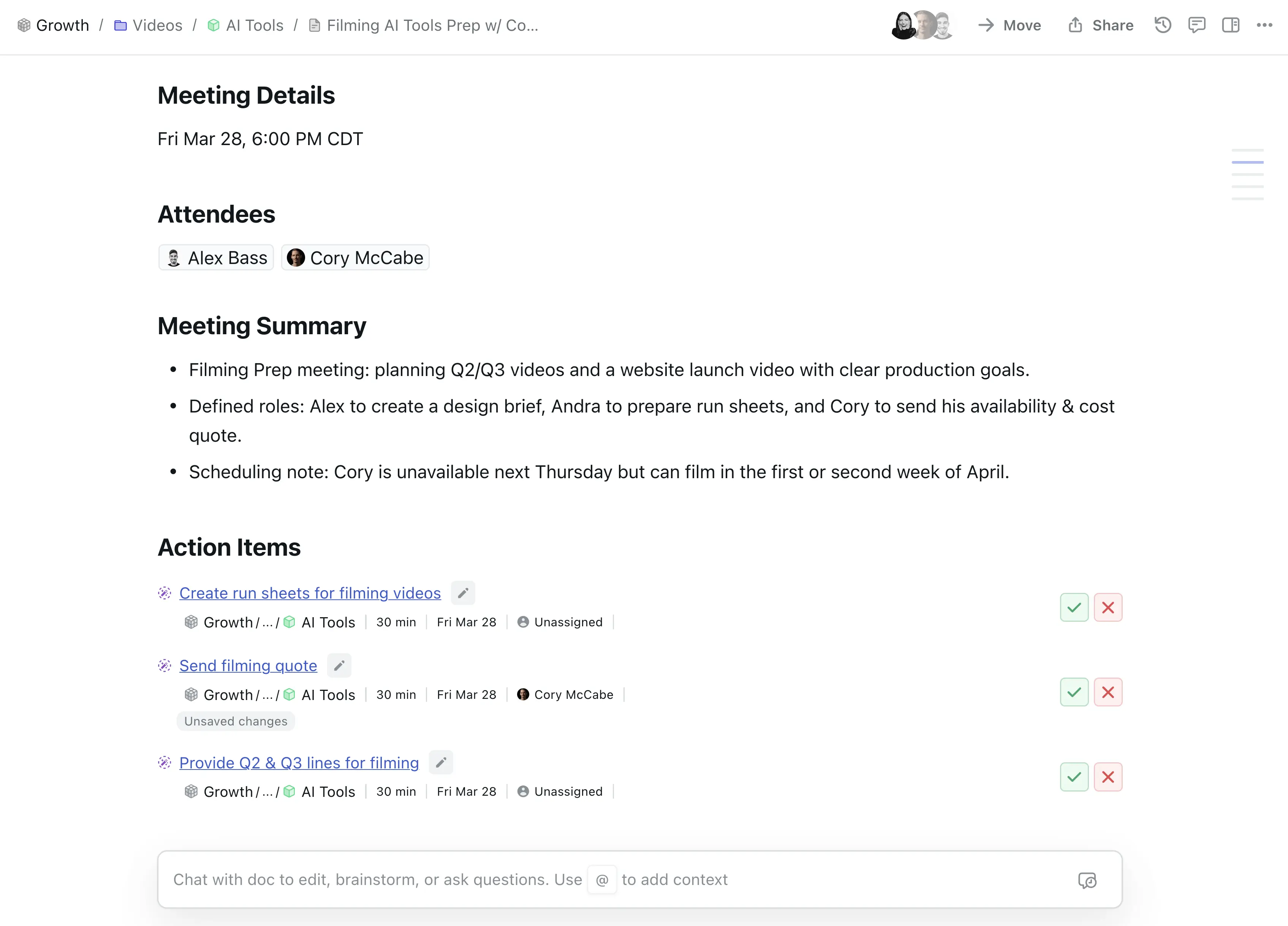
After each meeting, Motion pulls out to-dos and tasks for the team who were on the call. All you have to do is approve them.
And what's amazing is how integrated it all is. You can link meeting notes directly to projects in Motion, turn a note into a task, or even spin up a whole blog post from a single meeting!
It's seamless, it's powerful, and honestly, it's a 10 out of 10 feature.
Motion also has AI Docs, which are great for storing processes or notes since they’re fully integrated with your projects. They’re not as robust as top note-taking apps like Notion, and the AI isn’t at ChatGPT-5 level, but they’re solid for basic note-taking and formatting. If your team doesn't have a knowledge base yet, then Motion AI Docs are the perfect place to start.
We’re starting to move more of our notes from Slite into Motion because having all our business context in one place is valuable. Just know that while AI Docs are convenient and integrated, they might be a bit limited if you're used to working with a dedicated knowledge base.
If you are a busy professional that is more so looking for one of the best daily planner apps to help manage your task list instead of a full project management tool, Motion is also an excellent choice.
Compared to other daily planner alternatives Motion is pulling this entire category forward by leveraging AI, tasks mixed with calendar events, time blocking, and prioritization, to build an app that feels like more you have a personal assistant helping you manage your time. Motion is a great productivity tool for soloprenuers, freelancers, contractors and students.

Motion also adds in many quality of life features that makes it stand out when comparing Motion vs Google Calendar for example, like Travel Time which you can add with the click of a button to any event:
.webp)
This is where Motion excels when comparing it to the best calendar schedulers on the market. You can generate meeting scheduler pages and embed them on your website (that take into consideration your specific meeting times for that given event, e.g. we only do meetings on Tuesday/Thursday between 1–4pm, so that's reflected on the page). You can even have it check against team calendar availability (as well as your own work and personal calendar availability of course), allowing you to even generate the meeting request in plain text if that makes you feel better than sending someone to a meeting page:

Every task in Motion has a duration and a 'completed time' (so tasks can be partially completed). You can even break longer tasks into smaller pieces by enabling chunks. Pair that with automatic scheduling, and you'll see Motion's secret weapon in action — the AI at its core that organizes your schedule like an executive assistant.
With that, Motion's time tracking is best used just to get a rough idea of how much time you spent on each task.
If you're looking to track time against work for invoicing purposes, Motion isn't quite there. In that case, we'd recommend pairing it with one of the best dedicated time tracking apps if you need to get super granular.
Mix the task time tracking functionality with Motion being able to see team member's actual calendar events and availability and what you have is an actual team workload view unlike any other. The big miss with most project management software is that calendar is an afterthought, and yet if someone on your team is tied up in meetings all week and then they have critical tasks assigned to them, do you think they'll be able to get to them?

With Motion, this is made abundantly clear (even flagged automatically), whereas other project management tools literally require an executive assistant or full-time project manager to be monitoring in order to find these issues as they arise.
Some capacity planning, but Motion is the first tool we're actually seeing doing it.
Motion is always a keyboard shortcut away (OPT + C to view the calendar, OPT + A to quickly access your meeting scheduler, and finally OPT + SPACE to quick-add a task from anywhere on your computer. These shortcuts are one of the reasons we love using Motion. Whether you're in the browser and need to check your availability quickly, are curious if you have any upcoming meetings and then want to get right back where you left off, or simply think of a task you need added (for yourself or your team member), it's all just one keyboard shortcut away.
In addition to the web app desktop app, Motion has an iOS and Android app that is fully-featured, including the full calendar functionality, along with your complete project task lists, and quick access to booking links while on-the-go.
A fun feature Motion recently added to the iOS app is being able to use Siri to create tasks while on-the-go. Simply ask Siri to "create a task in Motion to review that presentation ASAP" and it will pop it on our calendar, rearranging all your other tasks. Now they just need to bring the feature to Google Assistant users too!
Project Management
The Motion project management tool on the mobile app is still in it's early phases. You can see your tasks in list view, but not on your kanban board for example. For this reason, we prefer to use the mobile app for tasks on the go but we prefer to use the desktop app and web app for project management and actually organizing projects/tasks and for getting work done.
We have to hand it to the team at Motion on this one—they launched an API, and then almost immediately spun up a Zapier integration to make their API even more accessible to others, something that newer tools in the space haven't invested in which makes Motion stand out, and something we greatly appreciate.
The API is surely to improve with time, adding in more functionality, although it does allow for the major things you'd want to use it for already, like create/find/update of tasks, and most importantly, creating the magic auto-scheduled task.
When comparing Motion's API with some of the leaders in project management like Asana, Motion does about 85% of what it needs to do for most integrations. We also know it'll get closer to 90–95% once they allow for custom fields, as functionality around "search tasks by custom field value" is surely to come with it.
The one thing to note though is that the API does not currently work with the appointment scheduling feature. For example, it does not allow for the same API functionality that a standalone scheduler tool like Calendly will give you on that front. That said, you can build some of this functionality by getting creative using a tool like Mailparser alongside Zapier (e.g. logging new appointments into your CRM upon booking), although I will say, it's not all that straightforward. 😅
All-in-all, Motion's API is getting there, and is likely to do what you'd need it to do on the project management front. We'd only say be aware if you're planning on building robust integrations based on their meeting scheduler, because if so, you might be better off using one of the best appointment scheduler apps in that case instead.
Native Integrations
Motion just released two native integrations, an email integration and Siri integration for the iOS mobile app.
Email Integration
The email integration allows you to easily forward your emails to Motion, and Motion will turn your email into a task and schedule it on your calendar. When forwarding your email to Motion, you can easily type in natural language the due date and priority. Motion will then find the best time to schedule the task using their AI schedular.
Motion Siri Integration
On the go? Try this new way of scheduling tasks. Simply tell Siri to create a task in Motion for you! Motion will find the best time to schedule the task on your calendar. This is super useful when on-the-go.
Start your 7 day free trial of Motion here.
Motion pricing is totally reasonable for all that it can do. Priced at $29 per month for individuals (on the annual plan), or $19 per user (team plan for 3+ seats). Keep in mind the fact that the tool also includes a project management tool, calendar and meeting scheduler which makes Motion worth it.
Annual Billing:
Monthly Billing (per user per month):
View full Motion pricing tiers & features on their site (to see which features are included in each tier)
Note: you cannot currently purchase a seats count outside of: 1/3/10/25, so if you need 7 seats, you'd just purchase the AI Employee Standard plan which gives 10 seats (this is the case for most of the leading project management software out there, including Asana, Monday, and others).
While some Motion app reviews mention that Motion pricing is expensive, it's actually comparable to Asana (for small teams, Motion and Asana are nearly identical per seat (paid annual). If comparing it to other daily planner apps, Motion is the only tool that has AI scheduling capabilities for tasks, and even with that it's priced nearly the same as it's competitors on the annual tier making it one of the more unique productivity tools on the market.
Whether you're a busy professional or a team, we think Motion is worth the price—we actually purchased the annual plan after just a week of using it.
You can view the full pricing tiers on Motion's site.
Our overall Motion app review? Well hopefully this says it all: we've actually fully switched to Motion from Asana after using Asana for 7+ years 😄
Motion app has been a game changer for our team and has allowed us to remember tasks we would have otherwise forgotten, manage projects and better collaborate as a team. Motion is definitely worth giving a try, especially if you have under 50 or so employees and are looking for a tool that is simple to use for everyone. Motion solidifies itself as a productivity tool that once you start using, it's hard to imagine life without it—the AI algorithm is something you feel missing from every other Motion alternative on the market.
If you're looking for a deeper dive comparison on the Motion project management tool, you can check out a deep dive project management comparison that covers all of that here.
Motion as a project management solution works well for teamwork projects, busy professionals, creative teams, remote teams, professional services and development teams. They don't have a free plan available but definitely give the free trial a shot before committing to a Motion alternative.
That said, we finally found what we've been looking for in terms of the perfect tool for our team (Oh and there's actually quite a bit more to the story if you're interested in hearing more).
Start your 7 day free trial of Motion here.
If you're looking for a Motion discount code or referral code, we've got you covered! For a limited time we're actually giving $100 off our Motion course for free if you sign up using any link on this page and filling out our Motion deal form.
.svg)
.svg)
.svg)
.svg)
.svg)
.svg)
.svg)

.webp)
.webp)
.webp)
.webp)
.webp)


We do not offer consulting services anymore, but we've done one better. For a fraction of the price from what we used to charge for software setup, we put together everything we know about Motion in our new Motion Course. We bring you inside of our account and show you exactly how we're using Motion here at Efficient App to create content and build product.
There are a few times where you'd actually want to open back up Google Calendar for certain things, like proposing a new time for example, or editing a team's calendar event (even if you're invited to it), so fixing these things will greatly improve the UX.
It would be nice to be able to have all of the normal Google Calendar functionality within Motion. That said, it does 99% of what you need on a daily basis, and in comparing Motion with the best calendar apps on the market, they all have these same limitations at the moment.
Motion allows for task chunking, breaking down larger tasks into smaller tasks. So the way we handle that situation is we'll create sub tasks just as checklists in the task, set the task to be a larger chunk of time (e.g. 4 hours) and then "enable chunking" and selecting say 30 minute chunks or 1 hour chunks.
That'll put the task on your calendar in 30–60 minute blocks of time, to which you can work through completing the entire task, completing the task chunk will update the task completion time accordingly.
Gantt charts are officially in Motion! We cover how we use them internally at Efficient App in our Motion Course.
%25201080p.webp)
If you're looking at Motion to manage your tasks, it's an incredibly robust task management tool and has just about every full-fledged project management feature that you could need. That said, if you're a large team with many layers of management, then it might be missing a few of those milestones and goal type reporting views. That said, Motion has teams of hundreds of employees using Motion, so unless you're an enterprise team of thousands, you should be able to get away with using Motion as a large team.
Motion has one of the most robust ListView and grouping/filtering features of any PM tool on the market, so while they don't have the traditional reporting functionality, you should be able to get much of what you need by simply building the view for the data that you're looking to view within the "All Tasks" view of Motion.
That said, what you get with Motion is customizable reports, or any reporting dashboards for that matter. That's not to say this won't come in the future, but for now the Motion team is focused on improving productivity for small + medium sized businesses and often times reporting features are required more at the enterprise level.
Yes, Motion allows for tracking habits by simply using recurring tasks, as while other tools talk about habits as if they are a totally separate feature, when in reality, all they are is a reoccurring task within a schedule restriction (e.g. nights only, 3 days per week, weekends only, etc.)
Motion actually used to have habits as a standalone feature, but they rebranded it to recurring tasks to enable others to benefit from being able to have tasks reoccur as well.
Time tracking is pretty core to Motion—for example, whenever adding a task, there's a "time estimation" field (duration), and a "completed time" field (completed X of Y hours). You can either manually update the "completed time" field after doing work, or "start task" which begins tracking time against the task while you're working on it.
Upon stopping the task, it adds the time you've worked to the task's "completed time" field. The cool thing here is that you can even tie in calendar event meetings into projects, so not all "work" needs to be tasks (unlike other time tracking software/PM tools).In terms of now how you get this in reporting though... You would need to organize a Listview to show all your tasks for the week/month, and then it'll show each task/meeting, and then have a rolled up "completed duration" field, grouped by week/month as an example like this:

This view is super customizable, so that's just an example. I don't think you can export, but you can just screenshot and it gets the same point across.
You can do the same exact thing as the screenshot above, but have it grouped by assignee instead, to show the entire team's time tracked:

.svg)

.webp)
.webp)
.webp)
.webp)
.webp)


We've tracked and verified the above companies are using this software in their team's stack.


.webp)
.webp)
.webp)
.webp)
.webp)